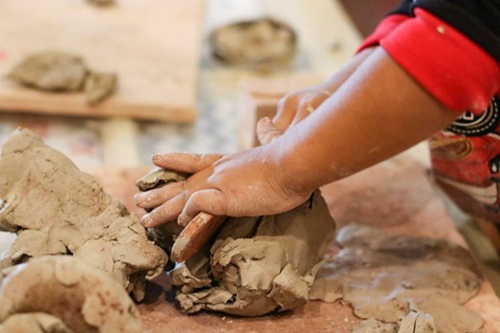Art Talk: Developing Visual and Verbal Literacy
| January 2006The National Association for the Education of Young Children (NAEYC) and the National Art Education Association (NAEA) have endorsed best practices for art experiences with young children. These practices include developmentally appropriate materials, equipment, and activities (Bredekamp & Copple 1997; Colbert & Taunton 1992). Adults are encouraged to facilitate young artists’ development by providing adequate opportunities for them to explore a variety of materials, media, and tools. In addition, adults are encouraged to extend children’s learning with verbal stimulation.
Visual and verbal literacy are developed through active experiences with the visual arts that include questioning and dialogue, what it often called “Art Talk.” According to Vygotsky (1962), higher forms of mental activity are constructed and transferred to children through dialogue with other people. Art making is often a social activity for young children where language is developed. What follows are suggestions for adults when they talk with children about their artwork.
Art Talk’s Key Points
Art Talk uses the Language of Art
The Language of Art incorporates the Elements and Principles of Design:
Elements, such as line, shape/form, color (hue, tint, shade), texture, space
Principles, such as balance, pattern (repetition, rhythm), proportion, emphasis, unity/variety, movement
Ask open-ended questions. Follow up yes/no questions with How? and Why?
Include talk about feelings and objects or representations in artwork
Make art and writing integrated experiences.
The “whole child” is developed when he or she engages in art making activities:
- Visual memory development
- Fine motor development
- Social-emotional development
- Cognitive development
Integrating Language With Visual Art Experiences
Learning about different artist’s techniques extends language. Talking with professional artists and reading about famous artists helps the young child develop a concept of “artist.” Resources and experiences include:
Art Resources
- Display reproductions of art by well-known artists, from calendars and museum postcards
- Read children’s books about artists
- Offer a wide range of age-appropriate materials for daily art experiences
Art Experiences
- Relate artists’ techniques with art activities in young children’s classrooms
- Develop the concept of artist with
- visits to art museums, galleries, and local artists’ studios
- visits to classroom by local artists and others involved in creative activities (neighbors and relatives)
Using the Language of Art
- Include vocabulary of elements and principles of design, such as line, shape, color, pattern, texture, etc. [See Althouse, R., M.H. Johnson & S.T. Mitchell, The Colors of Learning: Integrating the Visual Arts into the Early Childhood Curriculum, 2003, 130-136.]
- Engage children in guided discussions about artists, their work, and the children’s own artwork.
- Ask open-ended questions; follow up yes/no questions with how/why questions.
- ALWAYS include affirmation: to begin or conclude an Art Talk session. NEVER denigrate the work by asking, “What is it supposed to be?” Instead, affirm the child’s effort and expression: “You worked very hard (a long time) on your artwork.” “I think you invented a new technique here. Would you like to tell the others about it?” “Thank you for sharing your art ideas with us.” “Shall we put it on display? (write something on the back? let it dry so that we can roll it later to take home? keep in your portfolio?)”
Six Topics to Engage Young Children in Talk About Their Artwork
Johnson and Johnson-Grafe presented six topics appropriate to talking with children about their artwork at the 2005 NAEYC Annual Convention and Expo in Washington, DC. These topics are:
- Ideas-- Tell me (us) about your idea(s).
- Process-- How did you make your artwork? (or, your painting, sculpture, collage)
- Materials-- What materials (or tools) did you use?
- Knowledge-- (concepts, vocabulary, artists studied). What kinds of shapes did you use? Did you use shapes like Matisse did?
- Reflection-- What do you like best in your artwork? Do you want to add anything to your artwork?
- Future-- What will you make next? What would you like to learn more about (or, how to do)? While these topics work well with children who are beyond the young artists’ earliest art making, what if an adult is working with our youngest artists who are simply becoming acquainted with tools and materials: scribblers?
Art Talk with Scribblers
Schirrmacher (1997) describes three groups of scribblers: random, controlled, and named. Adults can perceive young children’s development through observation of their artmaking processes and products. “Random scribblers” are the youngest artists; they use large muscles and whole arm movements to make marks with various tools: markers, fingers in pudding, lipstick on walls, and so on, often marking without looking at their earliest “artistry.”
There is an opportunity in the school environment to develop young children’s language and understanding when talking with them about their artwork. This young artist, who may be considered a scribbler in paint, is using paintbrushes and tempera paint at the easel in his preschool:
Adapted from Sparling and Sparling’s 1973 article, “How to Talk with a Scribbler,” are suggestions about topics to use when talking with random, controlled, and named scribblers. Adults should validate the random scribbler’s art expression by talking about:
- Physical movements: See how you used blue paint and moved your paintbrush around and around in circles. See how the black paint mixed with the blue paint in your smaller strokes in the middle of your painting.
- Expressive qualities of the artwork: See how your blue paint is just a little darker than the blue paper. The blue colors give me a restful feeling. The black paint makes me focus on (adds a focal point to) the center of your painting.
- The child’s feelings: You worked a long time on that painting. You must have enjoyed using the tempera paint and paintbrush at the easel.
Note how the adult is using the language of art, above, to model Art Talk.
Controlled scribblers’ artwork is characterized by smaller marks and finer motor control of the media and tools. Controlled scribblers watch the actions of the tools with the media; and although they continue to experiment, they are beginning to make marks with intention and purpose.
Validate the controlled scribbler’s art expression by talking about:
- Getting control of the medium: See how you made a complete circle. See how you were able to hold your paintbrush to make smaller circles inside your larger circle.
- The way things look: See how you changed colors with the smaller circles. I think you must have remembered how to clean your paintbrush when you change colors. Your small circles look like dots to me. Let’s name the colors you used. The green dot gets my attention (stands out) because it is the only one. Now, let’s count how many red dots you made.
- The child’s feelings: You must be feeling proud that you kept your paintbrush clean when you changed colors with the tempera paints. I’ll bet you are feeling excited about the method you discovered (or, created) to repeat these dots to make a pattern.
- Named: scribblers enjoy telling others about their artwork. They make intentional marks and work with increased concentration. They give names to their marks, although their forms may simply be records of mark-making actions; and names may change at different times and for different purposes in story-telling.
Validate the named scribbler’s art expression by:
- Listening carefully to capitalize on the child’s intention or meaning.
- Verbally labeling things in the artwork. Written titles are appropriate and help to synthesize the art making experience.
- Using more complex art vocabulary in their “art talk.”
- If the child does not respond to “naming,” then simply return to earlier statements.
Interestingly, the preceding topics and suggestions are valuable strategies with children throughout their school years, and need not be reserved for “scribblers” only. But, what if a child of any age does not enjoy making art at all? In this case, try drawing, painting, or sculpting together; work side by side, exploring the materials. Share your thoughts, ideas, techniques, discoveries, as you work. If the child still does not participate, let him or her go to another center or activity of his/her choice. Tell the child you enjoyed the experience and that you look forward to doing it again sometime with him (or her). I have a hunch that you will.
Documenting Visual Arts Learning
What the child says about his or her artwork can become a form of assessing cognitive and aesthetic growth through documentation.
Documentation can:
- Contribute to the depth of children’s learning through their art projects and other works.
- Show that children’s art work is a visible representation of their experiences and conceptual development.
- Show that young children learn from and are stimulated by each other’s art work.
- Provide a means to help parents, administrators, and other teachers understand and become aware of young children’s work in the early childhood classroom
Document with:
- photographs
- post-it notes
- transparencies
- records of dialogue: written account, audiotape and videotapes
- the teacher’s “readings” of and notes about young children’s artwork
The program implements a curriculum that is consistent with its goals for children and promotes learning and development in each of the following domains: aesthetic, cognitive, emotional, language, physical, and social. (NAEYC 2005, Program Standard 2)
Copyright © 2006 Margaret Johnson. Reprint with permission only. All rights reserved.
References
Althouse, R., M.H. Johnson & S.T. Mitchell. 2003.>The Colors of Learning: Integrating the Visual Arts into the Early Childhood Curriculum New York: Teachers College Press; Washington, DC: NAEYC.
>Bredekamp, S. & C. Copple, eds. 1997. Developmentally appropriate practices in early childhood programs. Rev. ed. Washington, DC: NAEYC.
Colbert, C. & M. Taunton. 1992. Developmentally appropriate practices for the visual arts education of young children. Reston, VA: NAEA.
Johnson, M. & A. Johnson-Grafe. 2005. The language of art and the colors of learning: Using young children’s art experiences to develop language and understanding.
NAEYC Convention & Expo, Washington, DC. NAEYC. 2005. NAEYC Early childhood program standards: Program standard 2
Schirrmacher, R. 1997. Art and creative development for young children. 3rd ed. Albany, NY: Delmar.
Sparling, J. & M. Sparling. 1973. How to talk with a scribbler. Young Children, 28 (4): 333-341.
Vygotsky, L. 1962. Thought and Language. E. Hanfmann & G. Vakar, eds. & trans. Cambridge, MA: MIT Press.






